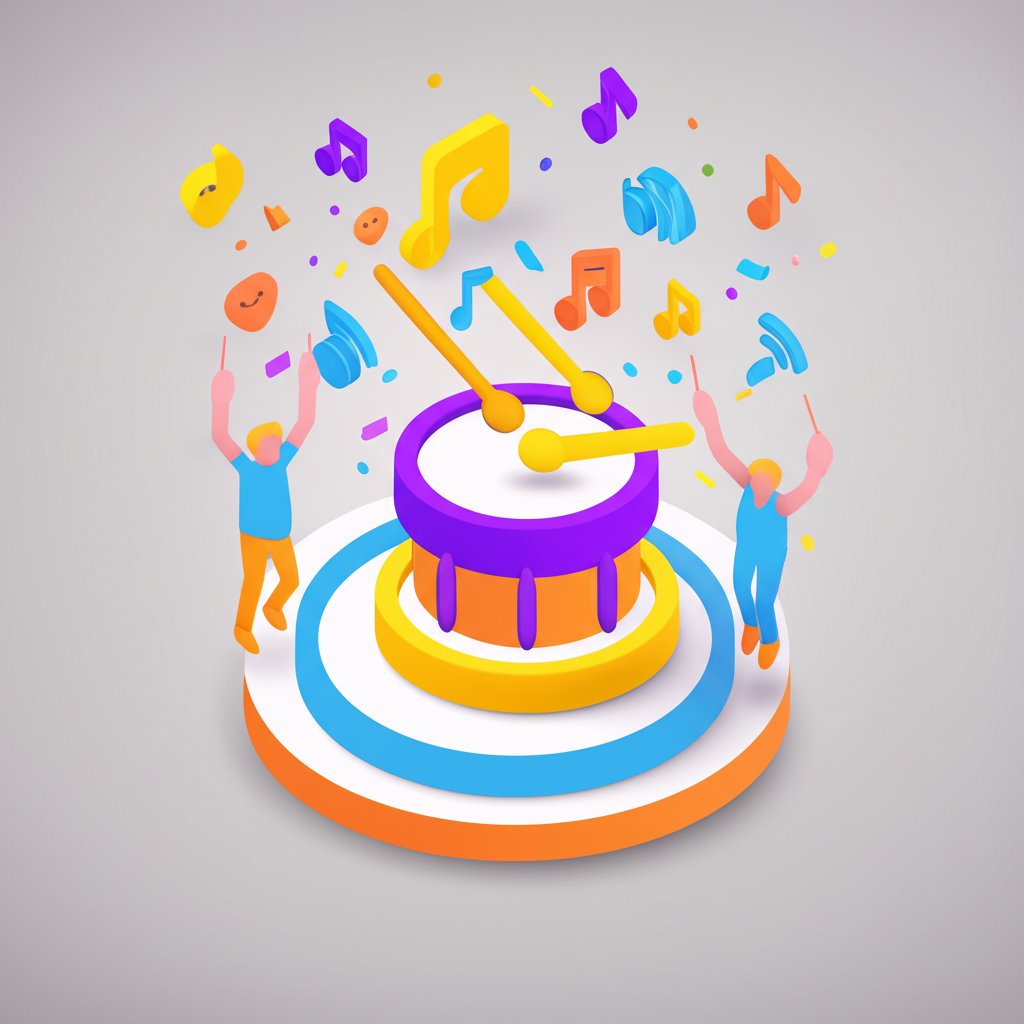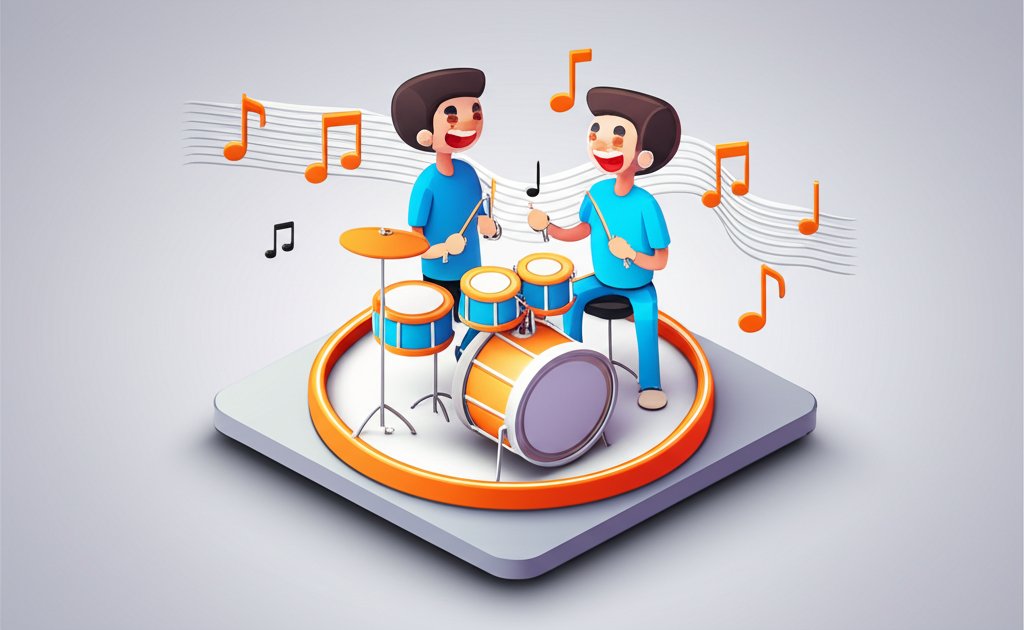Have you ever noticed the infectious grin on a drummer’s face, whether they’re pounding out a thunderous rock beat or laying down a subtle jazz groove? They are the undeniable pulse of any musical ensemble, the rhythmic engine that drives the entire performance. This consistent exuberance often sparks curiosity: what is the secret behind why drummers are happy? Is it just the adrenaline, or is there something deeper? This article will thoroughly explore the multifaceted reasons for drummers' happiness, delving into the scientific, psychological, physical, and social aspects that cultivate their profound drummers joy. Get ready to uncover the harmonious phenomenon that makes drummers some of the happiest musicians alive.
The Rhythmic Pulse: How Drumming Rewires Your Brain for Bliss

At the core of drummers' happiness lies the very essence of their craft: rhythm. The act of drumming isn’t just about striking a surface; it’s a deep, immersive experience that profoundly impacts the brain. This neurological engagement is a primary component of why drummers are happy.
The Flow State: Immersion in the Beat
One of the most powerful psychological benefits drummers experience is the “flow state.” Coined by psychologist Mihaly Csikszentmihalyi, flow is a mental state in which a person performing an activity is fully immersed in a feeling of energized focus, full involvement, and enjoyment in the process of the activity. For drummers, this means:
- Complete Presence: When they’re locked into a groove, the outside world fades away. Worries about work, personal problems, or daily stressors simply vanish as their entire focus is consumed by the intricate dance of their limbs and the precision of the beat.
- Optimal Challenge: Drumming offers an ideal balance between skill and challenge. It’s complex enough to demand full attention but achievable enough to avoid frustration, creating a continuous loop of engagement and satisfaction. This deep immersion is a direct pathway to
drummers joy. - Loss of Self-Consciousness: In the flow state, self-awareness diminishes, and the drummer becomes one with the music, experiencing a liberating sense of freedom and authenticity that is a hallmark of
drummers' happiness.
Endorphin Rush: Nature’s Euphoria on the Kit
The physical exertion involved in drumming triggers a powerful cocktail of neurochemicals in the brain, directly contributing to why drummers are happy.
- Endorphins and Enkephalins: Often called “natural painkillers” or “feel-good chemicals,” these opioids are released in response to physical activity. They create a sense of euphoria, reduce pain, and elevate mood significantly. This is akin to a “runner’s high,” but for percussionists.
- Dopamine Release: Drumming, especially when mastering a new pattern or nailing a difficult fill, stimulates the release of dopamine, a neurotransmitter associated with pleasure, reward, and motivation. This creates a positive feedback loop, encouraging drummers to seek out more drumming experiences and further enhancing their
drummers joy. - Serotonin and Noradrenaline: These neurotransmitters also play a role in mood regulation, sleep, and stress response. The rhythmic, repetitive nature of drumming helps to balance these chemicals, promoting a calm yet energized state.
Cognitive Cadence: Sharpening the Mind with Rhythm
Beyond just feeling good, drumming actively enhances cognitive abilities, leading to a sense of empowerment and capability that underpins drummers' happiness.
- Boosted Brain Power: Research, including studies from institutions like the Karolinska Institute, indicates that drumming can promote brain neuroplasticity. The constant coordination of all four limbs, often playing different
rhythmpatterns simultaneously, creates new neural pathways and strengthens existing ones. - Enhanced Focus and Concentration: Sustaining a complex beat requires intense concentration. Drummers become masters of sustained attention, filtering out distractions to maintain their rhythmic foundation. This sharpened focus translates to other areas of life, providing a strong sense of cognitive control.
- Multitasking Mastery: Coordinating bass drum, snare, hi-hat, and cymbals while listening to other musicians and maintaining the overall
rhythmis the ultimate multitasking challenge. This develops exceptional cognitive flexibility and the ability to process multiple strands of information simultaneously, leading to increased confidence anddrummers' happiness. - Problem-Solving Skills: Learning new grooves, adapting to unexpected changes in a live performance, or composing original parts all require creative problem-solving, further stimulating cognitive functions and fostering a sense of accomplishment.
Beyond the Beat: The Profound Mental & Emotional Benefits of Drummers' Joy
The mental and emotional landscape of a drummer is deeply shaped by their instrument. The drum kit serves not just as a musical tool, but as a therapeutic outlet and a vehicle for self-discovery, contributing significantly to drummers and happiness.
A Powerful Catharsis: Releasing Stress and Anxiety
One of the most immediate and visceral reasons why drummers are happy is the sheer cathartic release that drumming provides.
- Physical Release of Tension: The act of striking drums and cymbals allows for a safe and constructive outlet for pent-up energy, frustration, and even anger. It’s a physical manifestation of letting go, transforming internal pressure into outward, controlled force.
- Emotional Expression: Drums, with their foundational and primal sound, allow for raw emotional expression. A drummer can channel feelings—joy, sorrow, aggression, excitement—directly into the
rhythm, finding a voice for emotions that might otherwise be difficult to articulate. This ability to externalize feelings is a significant factor in reducing anxiety and promoting a sense of well-being. - Mindful Re-Patterning: The repetitive, predictable nature of
rhythmcan be incredibly soothing. It provides a structured framework for the mind, helping to interrupt cycles of negative thought and bringing a sense of order to internal chaos.
Creative Expression: Finding Your Voice Through Percussion
For many, drumming is less about making noise and more about crafting a narrative, which is a powerful source of drummers joy.
- Unleashing Creativity: Drummers are constantly interpreting, improvising, and composing. They shape the feel of a song, creating textures and dynamics that define its character. This creative freedom is deeply satisfying and fosters a strong sense of personal agency.
- Building Identity: Through their unique style, feel, and choice of
rhythmpatterns, drummers develop a distinct musical identity. This self-expression is validating and reinforces a sense of who they are as individuals and artists. - Mastery of Craft: The journey of learning and mastering drumming techniques, from basic beats to complex polyrhythms, provides a continuous sense of growth and achievement. This pursuit of mastery, with its tangible progress, is a wellspring of
drummers' happiness.
Mindfulness in Motion: Present Moment Power
Drumming inherently encourages a state of mindfulness, a key ingredient in lasting happiness.
- Anchoring to the Present: The demanding physical and mental coordination required means drummers cannot dwell on past regrets or future anxieties. They must be entirely present in the moment, focused on the current beat, the current
rhythm, and the current musical interaction. - Sensory Engagement: Drumming engages multiple senses: the feel of the sticks, the sound of the drums, the visual cues from bandmates. This rich sensory input further grounds the drummer in the present, fostering a deep appreciation for the immediate experience.
- Non-Judgmental Awareness: In the zone, drummers often experience a non-judgmental awareness of their actions, simply observing the musical output rather than critiquing it. This detachment from internal criticism is incredibly liberating and conducive to
drummers' happiness.
The Physicality of Happiness: A Full-Body Rhythm Workout
It’s often overlooked, but drumming is a demanding physical activity, and physical well-being is intrinsically linked to drummers' happiness. The physical benefits contribute significantly to why drummers are happy.
Cardio, Core, and Coordination: Fitness on the Kit
Drumming provides a comprehensive workout that rivals many traditional exercise routines.
- Cardiovascular Health: Sustained drumming can elevate heart rate to aerobic levels, improving cardiovascular fitness and endurance. This consistent physical activity is a known mood booster.
- Full-Body Engagement: Drummers engage their core for stability, their legs for pedal work, and their arms for striking and nuanced control. This builds strength, stamina, and improves overall physical fitness.
- Enhanced Coordination and Agility: The intricate limb independence required trains the body’s coordination to an exceptional degree, improving reflexes and fine motor skills. This physical prowess contributes to a strong sense of physical capability and vitality.
- Stress Reduction through Movement: Like any good workout, drumming helps to burn off excess energy and stress hormones, replacing them with invigorating sensations and a sense of accomplishment.
Immune System Boost & Pain Relief: The Healing Power of Rhythm
Remarkably, studies have shown that the rhythmic activity of drumming can have tangible health benefits beyond just fitness.
- Strengthened Immune System: Research suggests that group drumming, in particular, can boost the immune system by increasing natural killer cell activity, which helps fight off infections and diseases. This biological boost contributes to a general sense of well-being and resilience, enhancing
drummers' happiness. - Analgesic Effects: The release of endorphins and the immersive nature of drumming can act as a natural analgesic, providing relief from chronic pain and discomfort. By shifting focus and chemically altering the body’s pain perception, drummers can experience significant relief and improved quality of life.
- Improved Sleep: Regular physical activity and stress reduction through drumming can lead to better sleep quality, which is fundamental to mental clarity, emotional stability, and overall
happiness.
The Social & Purpose-Driven Aspects of Drummers' Happiness
Drummers rarely play in isolation. Their role within a group, the sense of purpose, and the shared experience are profound contributors to drummers and happiness.
The Heartbeat of the Band: Essential Role and Purpose
Drummers occupy a unique and indispensable position in nearly every musical ensemble, which imbues them with a strong sense of purpose.
- Providing the Foundation: The drummer is the architect of time and
rhythm, the anchor around which all other musicians build their parts. Without a solid drum beat, a song can easily fall apart. This foundational role is a source of immense pride. - Leading and Supporting: While often in the back, drummers are de facto leaders, dictating the tempo, feel, and energy of a performance. They also provide unwavering support, listening intently and adapting to the nuances of their bandmates. This balance of leadership and collaboration is deeply satisfying.
- Sense of Accomplishment: Contributing to a cohesive and powerful musical experience, knowing that their
rhythmis the driving force, fosters a profound sense of accomplishment and shared success. This feeling of being essential is a key reasonwhy drummers are happy.
Community and Connection: Shared Rhythm, Shared Joy
Music is a shared language, and drumming, in particular, fosters deep connections.
- Band Camaraderie: Playing together creates a unique bond among band members. The shared experience of rehearsal, performance, and creative collaboration builds strong friendships and a sense of belonging. This collective journey amplifies
drummers' happiness. - Drum Circles and Group Dynamics: Beyond formal bands, drum circles are ancient practices that bring people together through shared
rhythm. The synchronicity achieved in these groups promotes social cohesion, reduces feelings of isolation, and generates collectivejoy. - Audience Connection: The drummer’s energy is often the most palpable in a live setting, directly influencing the audience’s response. The experience of moving an audience, making them dance and feel, creates an exhilarating connection that feeds the drummer’s soul.
Mastery and Accomplishment: The Thrill of the Groove
The journey of a drummer is one of continuous learning and incremental victories, each contributing to their overall happiness.
- Overcoming Challenges: Learning a new beat, perfecting a complex fill, or improvising a spontaneous solo all represent challenges that, once conquered, provide immense satisfaction.
- The “Aha!” Moment: The feeling of finally “locking in” with a groove, where everything clicks into place and the
rhythmfeels effortless and powerful, is an unparalleled experience ofdrummers joy. - Personal Growth: The discipline, patience, and dedication required to master the drums foster personal growth that extends far beyond music. This self-improvement is a cornerstone of long-term
happiness.
Cultivating Your Inner Drummer: How to Embrace More Rhythm and Joy
While not everyone can become a world-class drummer, understanding why drummers are happy can inspire us all to incorporate more rhythm and joy into our daily lives.
Start Simple: Finding Your Personal Beat
You don’t need a drum kit to experience the benefits of rhythm.
- Body Percussion: Clap your hands, tap your feet, snap your fingers. Experiment with different
rhythmpatterns while listening to music or even just walking. - Everyday Objects: Use household items as instruments—a pen tapping on a desk, a spoon on a pot. Focus on creating a steady beat and exploring different sounds.
- Take a Class: Consider a beginner drum class or a drum circle. Many communities offer accessible ways to explore drumming and experience its immediate benefits.
Listen Actively: The Power of Rhythm in Everyday Life
Rhythm isn’t just in music; it’s all around us.
- Nature’s Rhythms: Pay attention to the
rhythmof waves, the patter of rain, the chirping of crickets, or your own heartbeat. Connecting with these natural patterns can be incredibly meditative and grounding. - Music Appreciation: Listen to music with a drummer’s ear. Focus on the groove, the dynamics, and how the
rhythmmakes you feel. Discovering new music genres can open up new avenues ofjoy. - Mindful Walking: Synchronize your breath with your steps, creating a natural internal
rhythm. This simple practice can clear your mind and reduce stress.
Embrace the Flow: Conscious Engagement with Tasks
The “flow state” isn’t exclusive to drummers. You can cultivate it in any activity.
- Set Clear Goals: For any task, define what success looks like.
- Eliminate Distractions: Create an environment where you can focus completely.
- Find the Right Challenge Level: Choose tasks that are neither too easy nor too difficult.
- Focus on the Process: Immerse yourself in the “doing” rather than solely the “outcome.” When you find yourself deeply engaged, you’re tapping into the same source of
joythat drummers experience.
Conclusion: Tapping into the Universal Beat of Happiness
The secret behind why drummers are happy is not enigmatic but rather a beautiful synergy of scientific, psychological, physical, and social factors. From the immediate neurological rewards of endorphins and dopamine, to the profound mental release and cognitive enhancement, to the sheer physical exhilaration and the deep sense of purpose within a musical community – drumming offers a holistic pathway to drummers' happiness. The immersive flow state, the cathartic emotional release, and the powerful sense of shared rhythm all contribute to an unparalleled drummers joy.
So, the next time you see a drummer radiating pure bliss, you’ll understand it’s not just a facade. It’s the profound impact of connecting with the universal beat, a testament to the power of rhythm to enrich lives. Whether you pick up sticks yourself or simply tune into the rhythm of your own life, embracing the lessons from these joyful percussionists can unlock a deeper sense of well-being and happiness for us all.
FAQ

Q: How does drumming specifically contribute to drummers' happiness from a scientific perspective?
A: Drumming significantly boosts drummers' happiness by triggering the release of endorphins, enkephalins, and dopamine, which are natural mood enhancers and pain relievers. It also engages the brain in a “flow state,” leading to deep immersion, reduced stress, and heightened cognitive function, all contributing to a profound sense of joy.
Q: What are the main mental health benefits that explain why drummers are happy?
A: Drummers experience substantial mental health benefits. Drumming acts as a powerful cathartic outlet for emotions, reducing stress and anxiety. It fosters creative expression and self-identity, and its rhythmic nature promotes mindfulness, grounding drummers in the present moment and enhancing their overall happiness.
Q: Does drumming have physical health benefits that impact drummers and happiness?
A: Absolutely. Drumming is a full-body workout that improves cardiovascular health, strengthens core muscles, and enhances coordination. This physical activity leads to increased fitness and energy, while also boosting the immune system and providing analgesic effects, all of which contribute positively to drummers and happiness.
Q: How does rhythm play a role in drummers joy and cognitive function?
A: Rhythm is central to drummers joy and cognitive benefits. The intricate, multi-limb coordination required in drumming enhances brain power, sharpens focus and concentration, improves multitasking abilities, and creates new neural connections. This mental agility and sense of accomplishment are powerful sources of happiness for drummers.
Q: What role do social connections and purpose play in drummers' happiness?
A: Drummers find immense happiness through their social roles and sense of purpose. As the heartbeat of any band, they provide the essential foundation and leadership, fostering a strong sense of accomplishment. The camaraderie with bandmates and the shared experience of creating rhythm in groups also cultivate deep social connections and collective joy.










